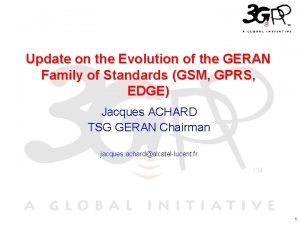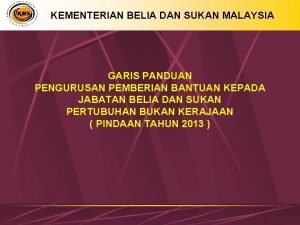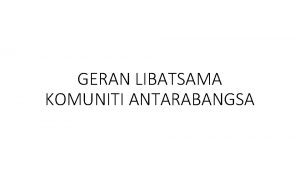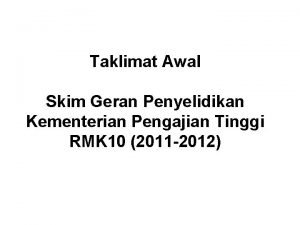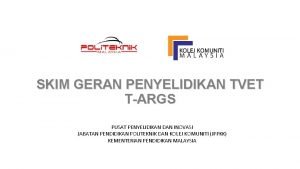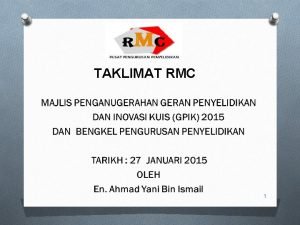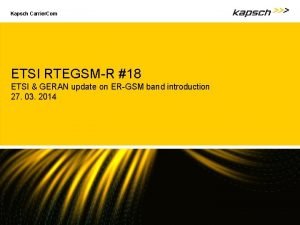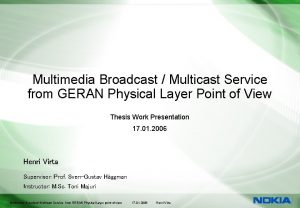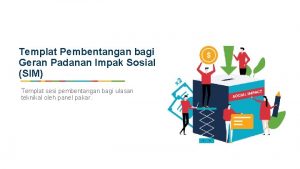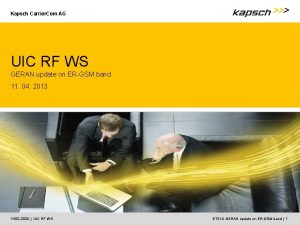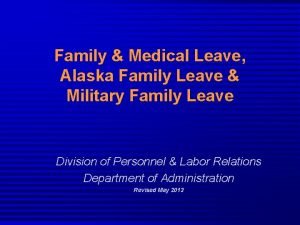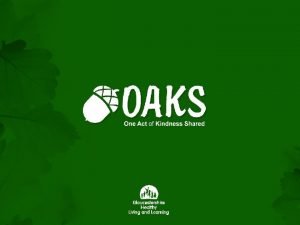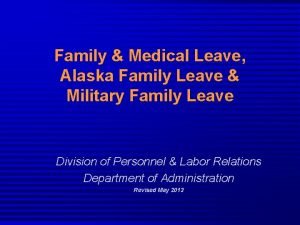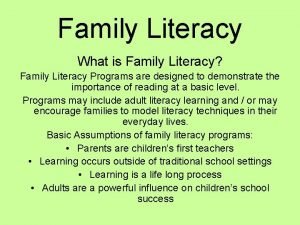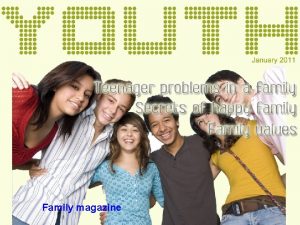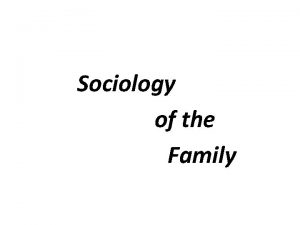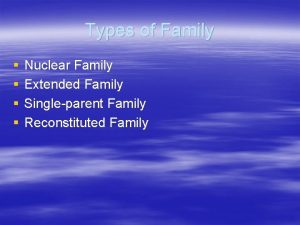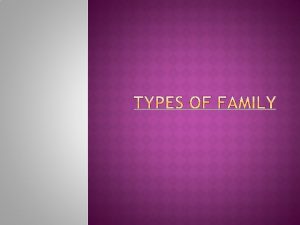Update on the Evolution of the GERAN Family
























- Slides: 24

Update on the Evolution of the GERAN Family of Standards (GSM, GPRS, EDGE) Jacques ACHARD TSG GERAN Chairman jacques. achard@alcatel-lucent. fr 1

Specifying GERAN Evolutions 1 2 3 4 5 6 7 What is TSG GERAN ? An overview of Release 99 to Release 6 Release 7 Release 8 For more information on GERAN Conclusion Appendix: list of acronyms 2

1 What is TSG GERAN ? • TSG GERAN Objectives: – GERAN = GSM/EDGE Radio Access Network – Responsible for the specification of the radio aspects of the GSM/EDGE technologies and their evolutions: • Brought under 3 GPP in 2000. • Formerly known as ETSI SMG 2. • TSG GERAN Organization: – Three subgroups: • Working Group 1: Radio Aspects (and BTS testing); • Working Group 2: Protocol Aspects; • Working Group 3: Terminal Testing. – Around 120 delegates. 3

TSG GERAN in 3 GPP organization Project Co-ordination Group (PCG) TSG GERAN GSM EDGE Radio Access Network GERAN WG 1 Radio Aspects TSG RAN Radio Access Networks RAN WG 1 Radio Layer 1 specification GERAN WG 2 Protocol Aspects GERAN WG 3 Terminal Testing RAN WG 2 TSG SA Services & System Aspects SA WG 1 Services TSG CT Core Network & Terminals CT WG 1 (ex CN 1) MM/CC/SM (lu) SA WG 2 Radio Layer 2 spec & Radio Layer 3 RR spec Architecture RAN WG 3 SA WG 3 Security CT WG 3 (ex CN 3) lub spec lur spec lu spec & UTRAN O&M requirements RAN WG 4 SA WG 4 CT WG 4 (ex CN 4) SA WG 5 CT WG 5 (ex CN 5) Radio Performance & Protocol Aspects RAN WG 5 (ex T 1) Mobile Terminal Conformance Testing Codec Telecom Management Interworking with External Networks MAP/GTP/BCH/SS OSA Open Service Access CT WG 6 (ex T 3) Smart Card Application Aspects 4

2 An overview of R’ 99 to Rel-6 5

3 Release 7 (main features) • Lower 700 MHz inclusion in the GERAN specifications a. k. a. GSM 710: • uplink: 728 -746 MHz; downlink: 698 -716 MHz (note: DL and UL recently reversed) • Addition of new frequency band to GSM (T-GSM 810): • uplink: 806 -821 MHz; downlink: 851 -866 MHz. • A-GNSS: • introduces Assisted Galileo in addition to Assisted GPS; • made in a generic way to allow quick introduction of other satellite constellations in the future. • A-GPS minimum performance: • specifies a minimum performance for the GPS receiver embedded in mobile stations using A-GPS over GERAN. • Enhancements of VGCS for public security officials (e. g. , police, fire brigade, using "public" GSM networks): • end-to-end ciphering; • SMS over VGCS; • emergency handling. 6

3 Release 7 (main features) • A interface control plane signalling over IP: • A interface signalling over M 3 UA/SCTP/IP. • DTM handover: • allows simultaneous handover of CS and PS resources for a given end-user. • PS Handover between GERAN/UTRAN mode and GAN mode: • complements the Rel-6 GAN with PS handovers between the unlicensed radio link and GSM/UMTS for improved service continuity (e. g. , when leaving home). • MS Receive Diversity (a. k. a. DARP Phase II): • improved downlink performance (quality and spectral efficiency) via use of dual antenna terminals. • Downlink Dual Carrier: • support of simultaneous transmissions to a given user over two independent GSM carriers on the downlink, enabling to double the downlink throughput for this user. • Latency Reductions: • reduces terminal to network round-trip time through the use of two techniques: – fact ack/nack reporting; – reduced Transmission Time Interval (RTTI = 10 ms instead of 20 ms). • paves the way for support of Vo. IP over GERAN • better support of delay-sensitive "conversational" type of applications • improves throughput of TCP-based applications due to the reduction of the roundtrip time. 7

3 Release 7 (main features) • EGPRS 2 UL: • addition of QPSK, 16 -QAM, 32 -QAM and higher symbol rate in uplink • comes in two flavours: – version A (EGPRS 2 -A UL): GMSK, 8 -PSK, 16 -QAM, legacy symbol rate 271 ksymbols/s; – version B (EGPRS 2 -B UL): GMSK, QPSK, 16 -QAM and 32 -QAM, higher symbol rate 325 ksymbols/s. • EGPRS 2 DL: • introduction of QPSK, 16 -QAM, 32 -QAM, higher symbol rate and turbo coding in downlink • comes in two flavours: – version A (EGPRS 2 -A DL): GMSK, 8 -PSK, 16 -QAM, 32 -QAM, turbo codes, legacy symbol rate 271 ksymbols/s; – version B (EGPRS 2 -B DL): GMSK, QPSK, 16 -QAM, 32 -QAM, turbo codes, higher symbol rate 325 ksymbols/s. 8

3 Rel-7: Focus on EGPRS 2 DL EGPRS 2 -A DL – GMSK, 8 PSK, 16 QAM, 32 QAM, – Legacy symbol rate 271 ksamples/s – Modulation and Coding Schemes : • legacy MCS-1 to MCS-4 from EGPRS (GMSK) • new DAS-5 to DAS-12 (8 PSK, 16 QAM, 32 QAM with turbo codes) * EGPRS 2 -B DL – GMSK, QPSK, 16 -QAM, 32 -QAM – Higher Symbol Rate (325 ksymbols/s) – Modulation and Coding Schemes: • legacy MCS-1 to MCS-4 from EGPRS (GMSK) • new DBS-5 to DBS-12 (QPSK, 16 QAM, 32 -QAM with turbo codes) ** Max throughput per TS : 98 kbit/s Data throughput per timeslot EGPRS 2 -A DL EDGE GPRS Max throughput per TS : 120 kbit/s * (MCS-7, MCS-8 also possible in certain conditions) ** (MCS-6 to MCS-9, DAS-5, DAS-6, DAS-9, DAS-10 pad, DAS-11, DAS-12 pad also possible in certain conditions) 9

3 Rel-7: Focus on EGPRS 2 UL EGPRS 2 -A UL : – GMSK, 8 PSK, 16 QAM – Legacy symbol rate 271 ksamples/s – Modulation and Coding Schemes : • reuse legacy MCS-1 to MCS-6 from EGPRS (GMSK & 8 -PSK) • new UAS-7 to UAS-11 (16 QAM) EGPRS 2 -B UL : – GMSK, QPSK, 16 QAM, 32 QAM – Higher Symbol Rate 325 ksamples/s – Modulation and Coding Schemes: • reuse legacy MCS-1 to MCS-4 from EGPRS (GMSK) • new UBS-5 to UBS-12 (QPSK, 16 QAM, 32 QAM) Max throughput per TS : 81. 6 kbit/s EGPRS 2 -A UL EDGE GPRS Max throughput per TS : 118 kbit/s 10

1. 3 Rel-7: Reaching 1 Mbit/s/user Bringing broadband to GSM • Downlink Max • Uplink Max 80 -120 kbit/s/TS 100 -120 kbit/s/TS x 4 multislot class 12 x 5 multislot class 33 x 2 320 -480 kbit/s Downlink Dual carrier 1 -1. 2 Mbit/s 11

4 Release 8 (main features) • GERAN-LTE interworking: • defines cell reselection and CS/PS handover between GERAN and LTE. • Multi-carrier BTS: • through the relaxation of certain GSM BTS radio requirements, allows to convey several GSM carriers with a single wideband transceiver, in order to bring capex and opex savings to the operators. • Feasibility study on MUROS (Multi-User Reusing One Slot): • aim is to double voice capacity of GERAN per BTS transceiver by sharing a single timeslot between up to 4 users; • Feasibility study on Optimized Transmit Pulse Shape for downlink EGPRS 2 -B: • analysis of a wider BTS transmit mask to further increase throughputs of EGPRS 2 -B downlink whilst checking potential impact on legacy bearers using legacy terminals. 12

4 Release 8 (main features) • A interface over IP: • support of A over IP (after support of Gb over IP in Rel-4); • allows to move the transcoders from the BSS to the Core Network (MGWs), allowing capex and opex savings for the operators. • GAN enhancements (GAN Iu mode): • allows to connect the GANC to 3 G Core Networks via the Iu interface. • Enhancements for VGCS Applications: • allows to send/receive a small amount of data to/from group members; • allows to transfer critical data within 500 ms without impacting voice quality of the group call; • gathers information on the identity of current listeners in the group call. • U-TDOA enhancements: • allows the MS to be powered at maximum power during the (brief) location procedure, in order to improve location accuracy. • A-GNSS performance and testing procedures: • specifies a minimum performance for the Galileo receiver embedded in mobile stations using A-GNSS over GERAN and defines a test framework for terminals that could be extended to the support of other constellations. • Additional Navigation Satellite Systems (ANSS) for LCS: • complements the GPS and Galileo constellations with other constellations like GLONASS, modernized GPS, QZSS, Satellite Based Augmentation Systems… 13

4 Rel-8: Focus on MCBTS • Purpose: allow GSM multicarrier transceiver architectures in order to: – reduce capex/opex for operators (several GSM carriers per transceiver); – ease migration from GSM to UMTS and or LTE (multicarrier wideband architectures allow multistandard transceivers). • Work started in 3 GPP TSG GERAN in September 2006, completed in August 2008. • Relaxations of BTS requirements on intermodulation, spurious emissions and blocking had to be introduced in the standards in order to allow the multicarrier architectures. • System simulations have shown that these relaxations can be introduced w/o reduction in system performance of GSM networks. 14

4 Rel-8: Focus on MUROS • Purpose: double the HW capacity of transceivers for CS speech by allowing 2 users (FR) or 4 users (HR) to share a single TS: – would bring CAPEX reduction in very densely populated areas where CS speech is the dominant service; – could allow operators migrating some of their GSM frequencies to UMTS/LTE to partly recover lost GSM capacity. • Several candidate techniques are currently under evaluation in the context of the MUROS Feasibility Study: – – • • • Orthogonal Sub-Channel (OSC); Adaptive Symbol Constellation; Co-TCH; Higher Order Modulations (HOM). All techniques in UL, except HOM, can be seen as variants of MUMIMO. Preliminary simulation results on one of the candidate techniques show capacity gains over HR and AMR HR for network configurations with high reuse factor and capacity losses for network configurations with low reuse factor. A Work Item is likely to be started soon to standardize the selected candidate technique(s). 15

4 Rel-8: Focus on A over IP (1/3) • Short description: – introduce IP transport over the A interface user plane between BSS and Core Network. • Performance gains: – bandwidth savings (OPEX savings) over the A interface because 64 kbit/s A or μ law speech can be replaced by any compressed GSM speech format (e. g. , AMR); – overall reduction in network processing power (CAPEX savings) since transcoders can be suppressed in the BSS and maintained only in the MGW. • Deployment scenario and applicability: – CAPEX and OPEX reductions for operators involved in IP transformation of their networks (NGN). • Current status in 3 GPP: – Specification work close to completion. 16

4 Rel-8: Focus on A over IP (2/3) BSS Nc MSC-S A (IP or TDM) Mc/IP TRAU A/TDM = Signalling = User plane MGW Nb MGW A/TDM TRAU = Transcoder Current legacy architecture (A over TDM) (excerpt from 3 GPP TR 43. 903 v. 8. 1. 0. ) 17

4 Rel-8: Focus on A over IP (3/3) A/IP MSC-S BSS Mc/IP A/IP = Signalling = User plane Nc MGW MSC-S A/IP BSS Mc/IP Nb MGW A/IP e. g. AMR coded IP based protocol stack = Transcoder or Transcoder-pair, typically not used in MS-to MS calls Architecture for compressed speech over IP, with transcoder-less BSS (excerpt from 3 GPP TR 43. 903 v. 8. 1. 0. ) 18

5 For more information on GERAN • 3 GPP TSG GERAN specifications are in the 4 x. xxx and 5 x. xxx series of 3 GPP specifications. • All are freely available and downloadable at: http: //www. 3 gpp. org/ftp/Specs/ • You can also mail 3 GPPContact@etsi. org for additional questions. 19

6 Conclusion (1/2) • The GSM radio interface has been evolving over the past years and keeps evolving to bring a host of additional features attractive to both operators and subscribers. • Evolution is mainly towards: – – more frequency bands; support of (additional) location techniques; higher throughputs; higher capacities (improved spectral efficiency and hardware efficiency); – interworking with other access technologies; – support of IP-based interfaces. 20

6 Conclusion (2/2) • This further increases GSM/GERAN attractiveness be it used: – for standalone networks; – for networks used in conjunction with other radio access technologies (UMTS, LTE. . . ) to provide global coverage whilst allowing excellent service continuity; – as a futureproof platform providing a smooth migration path towards other 3 GPP based systems (UMTS, LTE). GSM is still an incredibly alive and fast evolving standards ! 21

7 Appendix: list of acronyms (1/3) a. k. a: also known as ANSS: Additional Navigation Satellite Systems A-GNSS: Advanced Global Navigation Satellite System A-GPS: Assisted GPS AMR: Adaptive Multi Rate BSC: Base Station Controller BSS: Base Station Sub-system BTS: Base Transceiver Station CAPEX: Capital Expenditure CS: Circuit-Switched DARP: Downlink Advanced Receiver Performance DL: Downlink DTM: Dual Transfer Mode ECSD: Enhanced Circuit Switched Data EDGE: Enhanced Data rates for GSM Evolution EGPRS: Enhanced General Packet Radio Service EPC: Enhanced Power Control FR: Full Rate 22

7 Appendix: list of acronyms (2/3) GAN: Generic Access Network GANC: GAN Controller GERAN: GSM and EDGE Radio Access Network GLONASS: ГЛОНАСС: ГЛОбальная НАвигационная Спутниковая Система GMSK: Gaussian Minimum Shift Keying GPS: Global Positioning System HR: Half Rate HO: Handover HW: Hardware LCS: Location Services M 3 UA: MTP Level 3 User Adaptation layer MCBTS: Multi-carrier Base Transceiver Station MBMS: Multimedia Broadcast and Multicast Service MGW: Media Gateway MIMO: Multiple Inputs Multiple Outputs MSC: Mobile Switching Centre MSC-S: MSC Server MTBF: Multiple TBF MTP: Message Transfer Part MU-MIMO: Multi-User MIMO MUROS: Multi-User Reusing One Slot NACC: Network Assisted Cell Change NB: Narrowband 23

7 Appendix: list of acronyms (3/3) OPEX: Operational Expenditure PFC: Packet Flow Context PS: Packet-Switched PSK: Phase Shift Keying QAM: Quadrature Amplitude Modulation QPSK: Quadrature Phase Shift Keying QZSS: Quasi-Zenith Satellite System RTTI: Reduced Transmission Time Interval SAIC: Single Antenna Interference Cancellation SCTP: Stream Control Transport Protocol SMS: Short Message Service TAPS: TETRA Advanced Packet Service TBF: Temporary Block Flow TCP: Transmission Control Protocol TRAU: Transcoding and Rate Adaptation Unit TS: Time slot UL: Uplink U-TDOA: Uplink Time Difference Of Arrival VGCS: Voice Group Call Service Vo. IP: Voice over IP WB: Wideband w/o: without 24
 Geran gsm
Geran gsm Geran kementerian belia dan sukan
Geran kementerian belia dan sukan Deferred update and immediate update
Deferred update and immediate update Varies from family to family on the periodic table.
Varies from family to family on the periodic table. Blended family vs binuclear
Blended family vs binuclear Conjugal family
Conjugal family Quá trình desamine hóa có thể tạo ra
Quá trình desamine hóa có thể tạo ra Cong thức tính động năng
Cong thức tính động năng Sự nuôi và dạy con của hổ
Sự nuôi và dạy con của hổ Thế nào là mạng điện lắp đặt kiểu nổi
Thế nào là mạng điện lắp đặt kiểu nổi Dạng đột biến một nhiễm là
Dạng đột biến một nhiễm là Bổ thể
Bổ thể Vẽ hình chiếu đứng bằng cạnh của vật thể
Vẽ hình chiếu đứng bằng cạnh của vật thể Biện pháp chống mỏi cơ
Biện pháp chống mỏi cơ độ dài liên kết
độ dài liên kết Thiếu nhi thế giới liên hoan
Thiếu nhi thế giới liên hoan Chúa yêu trần thế alleluia
Chúa yêu trần thế alleluia điện thế nghỉ
điện thế nghỉ Một số thể thơ truyền thống
Một số thể thơ truyền thống Trời xanh đây là của chúng ta thể thơ
Trời xanh đây là của chúng ta thể thơ Số nguyên là gì
Số nguyên là gì đặc điểm cơ thể của người tối cổ
đặc điểm cơ thể của người tối cổ Tỉ lệ cơ thể trẻ em
Tỉ lệ cơ thể trẻ em Tia chieu sa te
Tia chieu sa te Các châu lục và đại dương trên thế giới
Các châu lục và đại dương trên thế giới
